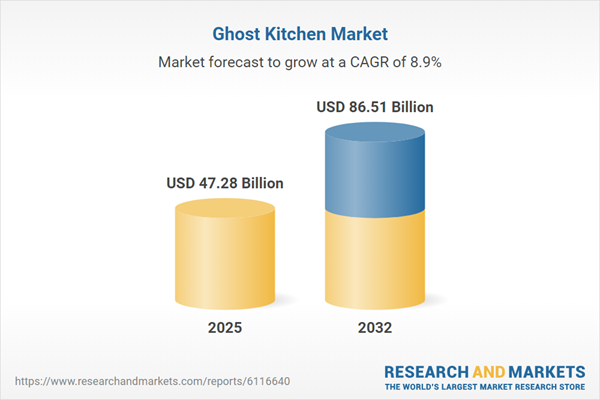Speak directly to the analyst to clarify any post sales queries you may have.
The ghost kitchen market is redefining food service delivery, driven by digital innovation and shifts in consumer expectations. Operators and decision-makers must navigate a complex landscape characterized by evolving business models, supply chain constraints, and emerging technologies.
Market Snapshot: Ghost Kitchen Market Size and Growth
The Ghost Kitchen Market expanded from USD 43.59 billion in 2024 to USD 47.28 billion in 2025, with projections indicating a sustained CAGR of 8.94% to reach USD 86.51 billion by 2032. This robust growth reflects surging demand for digital-first, on-demand dining and the rapid adoption of virtual kitchen models across key regions and demographics.
Scope & Segmentation of the Ghost Kitchen Market
This report analyzes the latest trends, business models, and strategic challenges shaping the sector. Segmentation offers a structure for evaluating investment, operational, and go-to-market strategies across the following categories:
- Business Model: Independent Ghost Kitchens, Kitchen-as-a-Service (KaaS), Restaurant-Branded Ghost Kitchens
- Service Type: Delivery, Pickup
- Cuisine: American, Chinese, Indian, Italian
- Kitchen Format: Brick and Mortar, Satellite Kitchen, Shipping Container
- Ordering Channel: Mobile App, Website
- Application: Corporate & Event Catering, Meal Subscriptions, Online Food Delivery, Pickup & Takeaway Services
- End User: Food Entrepreneurs, Individual Consumers, Institutions, Restaurants
- Geography: Americas (United States, Canada, Mexico, Brazil, Argentina, Chile, Colombia, Peru), Europe (UK, Germany, France, Russia, Italy, Spain, Netherlands, Sweden, Poland, Switzerland), Middle East (UAE, Saudi Arabia, Qatar, Turkey, Israel), Africa (South Africa, Nigeria, Egypt, Kenya), Asia-Pacific (China, India, Japan, Australia, South Korea, Indonesia, Thailand, Malaysia, Singapore, Taiwan)
Prominent technologies analyzed include automation solutions, cloud-based platforms, AI-driven systems, and kitchen robotics. Examined companies range from established delivery platforms to next-generation pure-play operators and technology providers.
Key Takeaways: Strategic Insights for Senior Decision-Makers
- Virtual kitchens are leveraging digital platforms to streamline order management, minimize capital outlays, and rapidly iterate menus, fostering entrepreneurial agility.
- Automation, predictive analytics, and real-time data integration are enabling operational efficiencies, reducing meal prep times, and enhancing consistency across locations.
- Operators are responding to shifting consumer preferences with tailored meal personalization, sustainable packaging initiatives, and integrated loyalty programs.
- Strategic collaborations, including partnerships with retailers and third-party logistics providers, are broadening channel reach and expanding revenue models.
- New business models, such as shared kitchen hubs and modular automation pods, create scalable entry points for market participants and support rapid geographic expansion.
- Market resilience is increasingly tied to diversified sourcing and proactive mitigation of supply chain risk, supporting cost management and quality assurance.
Tariff Impact: Navigating Policy Shifts and Supply Chain Costs
United States tariff adjustments in 2025 are altering cost structures for ghost kitchen operators, especially in sourcing raw materials, appliances, and packaging. These policy changes are prompting investment in domestic partnerships, consolidated procurement frameworks, and increased automation to buffer against input volatility. Effective risk management and agile sourcing are essential for safeguarding margins in a dynamic regulatory landscape.
Methodology & Data Sources
The research is based on a rigorous methodology combining primary insights from industry leaders with secondary validation across filings, trade publications, and regulatory disclosures. Analytical frameworks, including SWOT and PESTLE, support scenario analysis and data cross-verification to ensure accuracy and objectivity throughout the study.
Why This Report Matters to Industry Leaders
- Delivers a holistic market assessment, helping senior decision-makers benchmark operational strategies and make informed investment choices.
- Identifies core growth drivers, technology levers, and evolving business models to support competitive planning and innovation initiatives.
- Provides actionable segmentation and regional analysis, allowing organizations to fine-tune market entry, expansion, and partnership strategies.
Conclusion
The ghost kitchen market offers a dynamic environment rich with innovation, but also operational complexity. This report equips stakeholders with robust intelligence for navigating growth, optimizing resilience, and sustaining long-term value in virtual dining.
Table of Contents
3. Executive Summary
4. Market Overview
7. Cumulative Impact of Artificial Intelligence 2025
Companies Mentioned
The companies profiled in this Ghost Kitchen market report include:- Ghost Kitchen Brands
- Kitopi
- City Storage Systems LLC
- Reef Global Inc.
- DoorDash, Inc.
- Foodology
- Nextbite Brands LLC
- Roofoods Limited
- Uber Technologies Inc.
- Just-eat
- Karma Kitchen
- Kitchen Hub
- Frontier Kitchen
- Wow Bao LLC
- Kitchen Concepts LLC
- Bistrohub Technologies S.L.
- Lunchbox Technologies, Inc.
- Rich Products Corporation
- TGAL Inc.
- Grubhub Holdings Inc.
Table Information
| Report Attribute | Details |
|---|---|
| No. of Pages | 191 |
| Published | October 2025 |
| Forecast Period | 2025 - 2032 |
| Estimated Market Value ( USD | $ 47.28 Billion |
| Forecasted Market Value ( USD | $ 86.51 Billion |
| Compound Annual Growth Rate | 8.9% |
| Regions Covered | Global |
| No. of Companies Mentioned | 21 |









